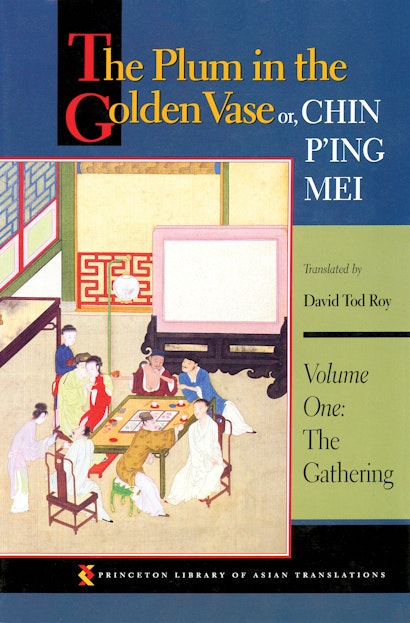This is the first volume in David Roy’s celebrated translation of one of the most famous and important novels in Chinese literature. The Plum in the Golden Vase or, Chin P’ing Mei is an anonymous sixteenth-century work that focuses on the domestic life of Hsi-men Ch’ing, a corrupt, upwardly mobile merchant in a provincial town, who maintains a harem of six wives and concubines. The novel, known primarily for its erotic realism, is also a landmark in the development of the narrative art form—not only from a specifically Chinese perspective but in a world-historical context.
With the possible exception of The Tale of Genji (1010) and Don Quixote (1615), there is no earlier work of prose fiction of equal sophistication in world literature. Although its importance in the history of Chinese narrative has long been recognized, the technical virtuosity of the author, which is more reminiscent of the Dickens of Bleak House, the Joyce of Ulysses, or the Nabokov of Lolita than anything in the earlier Chinese fiction tradition, has not yet received adequate recognition. This is partly because all of the existing European translations are either abridged or based on an inferior recension of the text. This translation and its annotation aim to faithfully represent and elucidate all the rhetorical features of the original in its most authentic form and thereby enable the Western reader to appreciate this Chinese masterpiece at its true worth.
Awards and Recognition
- One of Choice's Outstanding Academic Titles for 1994
David Tod Roy (1933–2016) was professor emeritus of Chinese literature at the University of Chicago. His monumental five-volume translation of the Chin P'ing Mei was completed in 2013.
"[A] book of manners for the debauched. Its readers in the late Ming period likely hid it under their bedcovers."—Amy Tan, New York Times Book Review
"[I]t is time to remind ourselves that The Plum in the Golden Vase is not just about sex, whether the numerous descriptions of sexual acts throughout the novel be viewed as titillating, harshly realistic, or, in Mr. Roy's words, intended 'to express in the most powerful metaphor available to him the author's contempt for the sort of persons who indulge in them.' The novel is a sprawling panorama of life and times in urban China, allegedly set safely in the Sung dynasty, but transparently contemporary to the author's late sixteenth-century world, as scores of internal references demonstrate. The eight hundred or so men, women, and children who appear in the book cover a breath-taking variety of human types, and encompass pretty much every imaginable mood and genre—from sadism to tenderness, from light humor to philosophical musings, from acute social commentary to outrageous satire."—Jonathan Spence, New York Review of Books
"David Tod Roy enters with zest into the spirit and the letter of the original, quite surpassing ... other earlier versions."—Paul St. John Mackintosh, Literary Review
"Reading Roy's translation is a remarkable experience."—Robert Chatain, Chicago Tribune Review of Books
"What Roy has already accomplished [in this volume] is enough to establish his translation as definitive. . . . A tremendous achievement."—Charles Horner, Commentary
"This is the first complete English translation of world literature and will immediately supersede all existing partial and abridged translations in that language. Even aside from the stunning achievement of the translation itself, the book represents a lifetime of meticulous scholarship on an enormous number of Sinological subjects. This work is the culmination of David Roy's entire scholarly career and a compendium of his vast learning in all phases of traditional Chinese civilization."—Andrew Plaks, Princeton University

